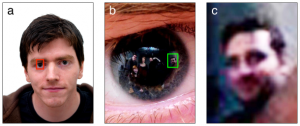
In the middle image, five bystanders are clearly visible in the zoomed-in corneal reflection.
(Credit: PLOS One)
Investigators already use images from security cameras and photographs snapped by bystanders to solve crimes, but a new study suggests criminal evidence could actually be found in photos that capture the reflections in bystanders’ eyes.
Researchers from the University of York and the University of Glasgow used high-resolution photography to zoom in on faces and eyes in photos to see what’s reflected back through bystanders’ corneas, and found that observers were able to identify the images accurately, despite their low resolution.
“The pupil of the eye is like a black mirror,” research leader Rob Jenkins of the University of York’s Department of Psychology said in a statement. “To enhance the image, you have to zoom in and adjust the contrast. A face image that is recovered from a reflection in the subject’s eye is about 30,000 times smaller than the subject’s face. Our findings thus highlight the remarkable robustness of human face recognition, as well as the untapped potential of high-resolution photography.”
The scientists used a 39-megapixel digital camera to shoot high-resolution passport-style photographs of eight individuals in front of staged “witnesses,” making sure those “witnesses” were reflected in the individuals’ corneas.
Then the scientists showed zoomed-in versions of the witnesses to a control group tasked with matching these highly pixelated faces to normal, in-focus profile pictures. The results showed that the bystanders’ faces — even when very pixelated — were recognizable.
Read the full story on CNET: http://news.cnet.com/8301-17938_105-57616894-1/do-the-eyes-have-it-how-corneal-reflections-could-help-solve-crimes/



